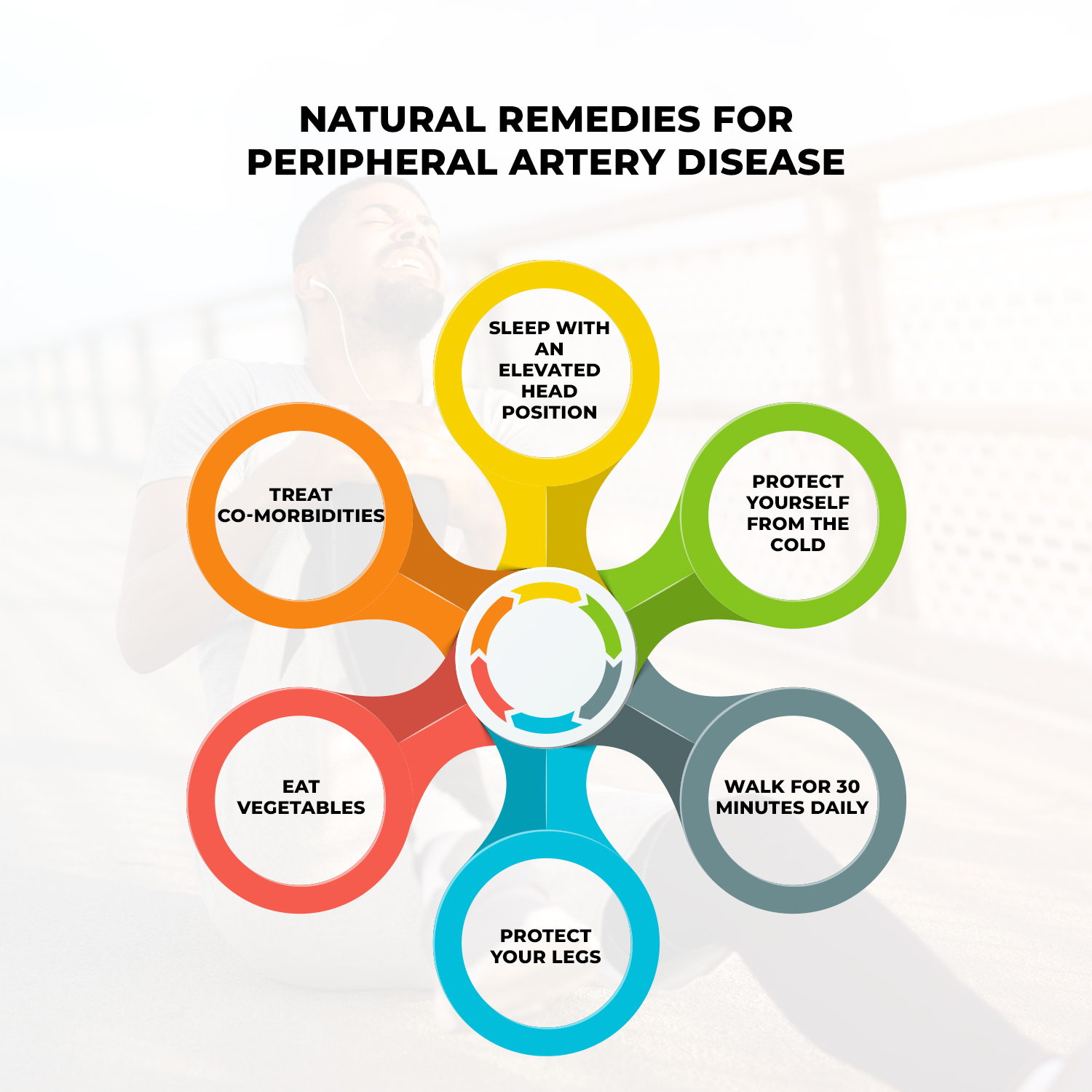


Table of Contents
Have you ever experienced lower limb pain while walking, running, climbing, or doing exercise? This can be due to insufficient blood flow to the lower extremity. When this happens, it indicates a problem with the artery that carries blood to the lower extremities, and this problem is known as peripheral arterial disease. Peripheral artery disease occurs when the blood supply to an area (usually the lower and upper limbs) in the body outside of the heart is cut off.
Peripheral arterial disease is one of the leading causes of amputations worldwide. This happens when insufficient blood flow to an area causes tissue death in that area. To remove this dead tissue and prevent the further spread of the disease, the person is advised to amputate the leg. Because of this alarming situation, it is important to know how to control it naturally.
In this post, you will learn the importance of Peripheral Arterial Disease, the types, causes, symptoms, preventions, and some natural remedies for Peripheral Arterial Disease. Stay tuned!
What is Peripheral Artery Disease?
An artery is a blood vessel that helps carry oxygen-rich blood from the heart to the body’s tissues.
Peripheral arterial disease can, therefore, be defined as a disruption in the circulation of oxygen-rich blood that supplies the areas outside the heart and brain, particularly the lower limbs. The disruption in blood flow to the areas results in an inadequate supply of nutrients, particularly oxygen, to those areas. This can cause cyanosis and lead to tissue death; A condition known as necrosis.
Types Of Peripheral Arterial Disease
The following are the types of peripheral artery disease:
Functional Peripheral Arterial Disease
Functional peripheral arterial disease is a blood circulation disorder that occurs when the normal dilation and build-up of blood vessels is excessive, usually altered by changes in the environment (e.g., changes in temperature), causing the blood vessels to constrict and narrow than normal
Occlusive Peripheral Arterial Disease
Occlusive peripheral arterial disease is a circulatory disorder caused by the accumulation of plaque (fat) in the arterial blood vessels outside the heart and brain. When these plaques build up in the artery wall, it causes the walls to harden, which can narrow blood flow. The plagues can also block the blood vessel, thereby preventing blood flow to the areas that need it.
Stages Of Peripheral Arterial Disease
Asymptomatic stage
At this stage, there are no visible symptoms to suggest that a person has a peripheral arterial disease.
Claudication Stage
At this stage, pain in the lower extremity appears, especially during physical activities such as walking, and climbing stairs. The pain may stop during rest but resumes immediately once physical activity is started.
Critical Limb Ischemia Stage
At this stage, prompt and appropriate treatment should be given as the arteries are severely clogged and you begin to get sores, blisters, and sores that take time to heal or do not heal at all. Critical limb ischemia can be referred to as chronic peripheral arterial disease because it often occurs after a long period of illness.
Stage Of Acute Limb Ischemia
At this stage, the arterial supply to the limb is completely blocked and there is no blood supply to the area. Those affected suffer from extreme pain and the pulse cannot be felt. This can jeopardize the existence of limbs and the person could consider amputation. Therefore, when the peripheral arterial disease reaches this stage, it is considered a state of emergency.
Risk Factors Of Peripheral Arterial Disease
Old Age
Old age is one of the risk factors for peripheral arterial disease. It is common in people who are 65 years of age and older. With age, the arterial wall hardens with plague deposits. This leads to a narrowing of the blood vessels.
High Blood Pressure
When the pressure of blood against the artery wall of the heart increases abnormally, the artery wall can be damaged. When the artery wall is damaged, it loses its elasticity and blood cannot circulate well to needed areas in the body. This puts high blood pressure at risk for peripheral arterial disease
Diabetes
People who have diabetes also have a higher risk of developing peripheral artery disease than those who don’t have it. High levels of glucose in the blood can cause blood vessels to narrow and damage the arterial wall. This restricts proper blood flow to the legs.
Smoking
Smoking is one of the biggest risk factors for developing peripheral arterial disease. Studies have shown that half of the people diagnosed with pulmonary artery disease are due to smoking. Both active and passive smokers are affected. Smoking makes the blood sticky and causes blood clots to form. The nicotine found in tobacco causes blood vessels to constrict, restricting blood flow to the areas that are needed. Smoking is also the main risk factor for other cardiovascular diseases such as coronary artery disease, heart failure, heart attack, etc.
Obesity
Obesity is also a risk factor for peripheral arterial disease. When there is too much fat in the body, it can build up in the artery wall and block blood flow.
High Cholesterol
High blood cholesterol also causes plaque to build up in the artery wall and restricts blood flow to the legs.
Family History
A person with a family history of the peripheral arterial disease has a higher risk of getting it than people without a family history. This means that the disease can be hereditary
Blood Clotting Disorder
A bleeding disorder is a serious condition that causes blood to clot abnormally. When the arterial supply to the legs has a clot, there is insufficient blood flow to the legs, which can lead to peripheral arterial disease.
Symptoms Of Peripheral Arterial Disease
- Bluish discoloration is known as cyanosis, especially on the feet and fingers
- Numbness, tingling
- Weakness of upper and lower limbs
- Hair loss in the affected area
- Blisters or sores in the lower extremity
- Feeling cold in the affected limb compared to the unaffected limb
- Erectile dysfunction
- Heaviness in legs when walking
- Stunted growth of toenails
- Claudication, which is pain and burning in the leg muscles when walking.
Complications Of Peripheral Artery Disease

Complications Of Peripheral Artery Disease
Amputation
The most well-known complication of peripheral arterial disease is the amputation of the affected extremity. Failure to get enough oxygen to the limbs will result in tissue death and severe pain. In severe cases, the affected limb may be amputated. It is common in people with peripheral arterial disease who also have diabetes.
Heart Attack
When fat builds up in the artery wall, blood flow to the heart is also reduced, and the amount of oxygen delivered to the heart is also reduced, this will limit its function. This leads to a heart attack.
Stroke
People with peripheral arterial disease have a higher risk of stroke, with transient ischemic attack being the most prominent. A transient ischemic attack is a temporary disruption in the blood supply to the brain
Renal artery disease
Renal artery disease occurs as a result of blood flow to the kidneys. When the artery is blocked, blood flow is restricted and the kidney is deprived of oxygen
Abdominal Aortic Aneurysm
An abdominal aortic aneurysm is the enlargement of the main artery in the abdomen. In peripheral artery disease, an artery becomes blocked and blood becomes blocked in the aorta. This weakens and enlarges the arterial wall.
Prevention Of Peripheral Arterial Disease
Quit Smoking
It is very important to quit smoking. This is because it reduces your chances of developing peripheral artery disease and other cardiovascular diseases. If you are interested in quitting smoking, consult your doctor for appropriate cessation procedures.
Avoid Foods With High Cholesterol
It is important to control your cholesterol levels. Bad cholesterol, or low-density lipoprotein (LDL), causes fat to build up in the artery wall. This narrows the wall and disrupts normal blood flow. Foods that are high in bad cholesterol are fries, butter, cheese, fast foods, etc. It is important to reduce or completely avoid these foods.
Exercise
Exercise is one of the ways to prevent peripheral vascular disease. It is important to exercise regularly. This is because exercise helps increase blood flow and prevent blood from clotting. Exercise also helps reduce fats that build up in the artery wall. This allows excess fats to be eliminated instead of causing problems.
Control Your Blood Sugar
Controlling your blood sugar levels helps prevent peripheral arterial disease. When you control your blood sugar, you prevent damaging the inner lining of your blood vessels and keep blood flow to your legs at optimal levels.
Natural Remedies For Peripheral Artery Disease

7 Best Natural Remedies For Peripheral Artery Disease
Sleep With An Elevated Head Position
Make sure your head is up when you go to sleep. This can be achieved through the use of pillows. Elevating the head increases blood flow to the heart and other parts of the body, allowing for proper breathing during sleep. This prevents sleep apnea, ensures good sleep, and relieves pain in the affected extremity.
Protect Yourself From The Cold
It is important to protect yourself from the cold to allow free blood flow. Peripheral arterial disease is caused by the narrowing of the blood vessels. When the body is exposed to cold, the already constricted vessel narrows further, which can lead to cramps and numbness and worsen the condition. It is therefore important to protect yourself from the cold.
Walk For 30 Minutes Daily
Walking is one of the ways that peripheral artery disease can be treated. It is important to walk for at least 30 minutes a day. The duration of walking should be between 30 and 60 minutes per day. The way of walking should be like this: you walk until you begin to feel moderate pain, then rest and after the pain completely disappears, start walking again
Protect Your Legs
People with the peripheral arterial disease are more prone to hard-to-heal wounds. They also have sores and blisters. This must be taken into account and appropriate footwear must be worn to prevent this. If you notice any of these, it’s important to consult your doctor immediately.
Eat Vegetables
Various studies have shown that eating 3 or more servings of vegetables daily reduces the risk of developing peripheral artery disease in the first place. This means that eating vegetables is useful for both preventing and curing peripheral artery disease. Vegetables contain sterols that help in the rapid absorption of cholesterol into the blood and also prevent bad cholesterol from entering the body. So, when you replace your fatty foods with vegetables, you reduce your bad cholesterol levels, which can form plagues that build up in the artery walls and cause constriction of the blood that supplies your legs.
Treat Co-morbidities
Co-morbidities are other medical conditions that are present in a person’s body at the same time. It is important to treat other conditions (such as diabetes, high blood pressure, high cholesterol, etc.) appropriately to reduce their impact on peripheral artery disease.
Final Thoughts
The above natural remedies are said to help in the treatment of peripheral arterial disease. It is very important to protect your legs from wounds, especially for diabetics. This is to prevent your legs from being amputated. Immediate treatment is required to prevent this. However, if natural remedies for peripheral artery disease do not reduce or eliminate the symptoms you feel, you should see your doctor immediately for expert treatment.
Post Disclaimer
The information contained in this post "7 Best Natural Remedies For Peripheral Artery Disease" is for educational purposes only. Always consult your primary care doctor before using the remedies that are provided. The information is provided by The Hidden Cures and while we do timely, in-depth research on the information that we provide to you, everything stated may not be up to date or accurate from the time it was written.



